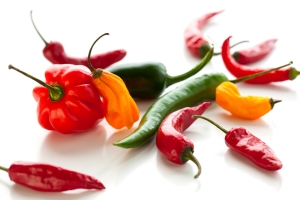This afternoon I’m cutting up a jalapeno from the farmer’s market and touch it to my tongue to find out how hot it is before adding it to hummus. Ah, a nice, strong tingle of heat. I toss it into the blender and turn to the sink to wash my hands, but my eye itches, and without thinking I rub it.
It’s as though I’ve stuck a knife directly into my eye. Not just any knife, but one with serrated edges that is sawing back and forth along the tender surface of my eyeball’s orb. White-hot pain that makes me gasp and clutch, turning in circles in my kitchen.
With my one good eye I find the sink and begin splashing water with the desperation of one plunging into a river when one’s clothes are afire. My hands can’t move fast enough, trying to drench the flames that have overtaken my right eye. My hair, my shirt—everything is dripping.
No! No! Water’s making it worse! The knife is getting bigger, hotter, cutting through my eyeball and getting closer to the retina. If anything, the pain’s intensifying; my eye feels like a piece of meat thrown onto the grill for searing. The flames are licking up into my forehead.
At that moment my brain dredges up a piece of information I’d long forgotten: drink milk, not water, to disperse burning oils. I rush to the fridge, choosing—being even now, in excruciating pain, an economical Dutchman—a small open carton of 2 percent milk from the back of the fridge, rather than opening a new gallon container.
Aargh! The small carton has soured and congealed! I rush back and tear the lid off the new gallon container, splash some into a mug, and fling it into my eye.
Instant relief. The flames are out, with just little wisps of smoke coming from the charred flesh that used to be my eyeball.
****
The point of this descriptive exercise, besides getting the word out about milk, is to get you into my skin for a moment, so that you can vicariously experience hot pepper juice in your eye.
And if I can get you to feel that, then perhaps I can also get you to get into my characters’ skin for a moment (or longer), to feel different kinds of pain: the entangling barbs of a divorce, the sting of humiliation, the frustration of voicelessness, the bottomless, starving ache of loneliness.
Some advice on how to do this, from one of my mentors, C.S. Lewis:
“Don’t use adjectives which merely tell us how you want us to feel about the things you are describing. I mean, instead of telling us a thing was ‘terrible,’ describe it so that we’ll be terrified. Don’t say it was ‘delightful’; make us say ‘delightful’ when we’ve read the description. You see, all those words ( horrifying, wonderful, hideous, exquisite) are only like saying to your readers, ‘Please, will you do my job for me?’”
